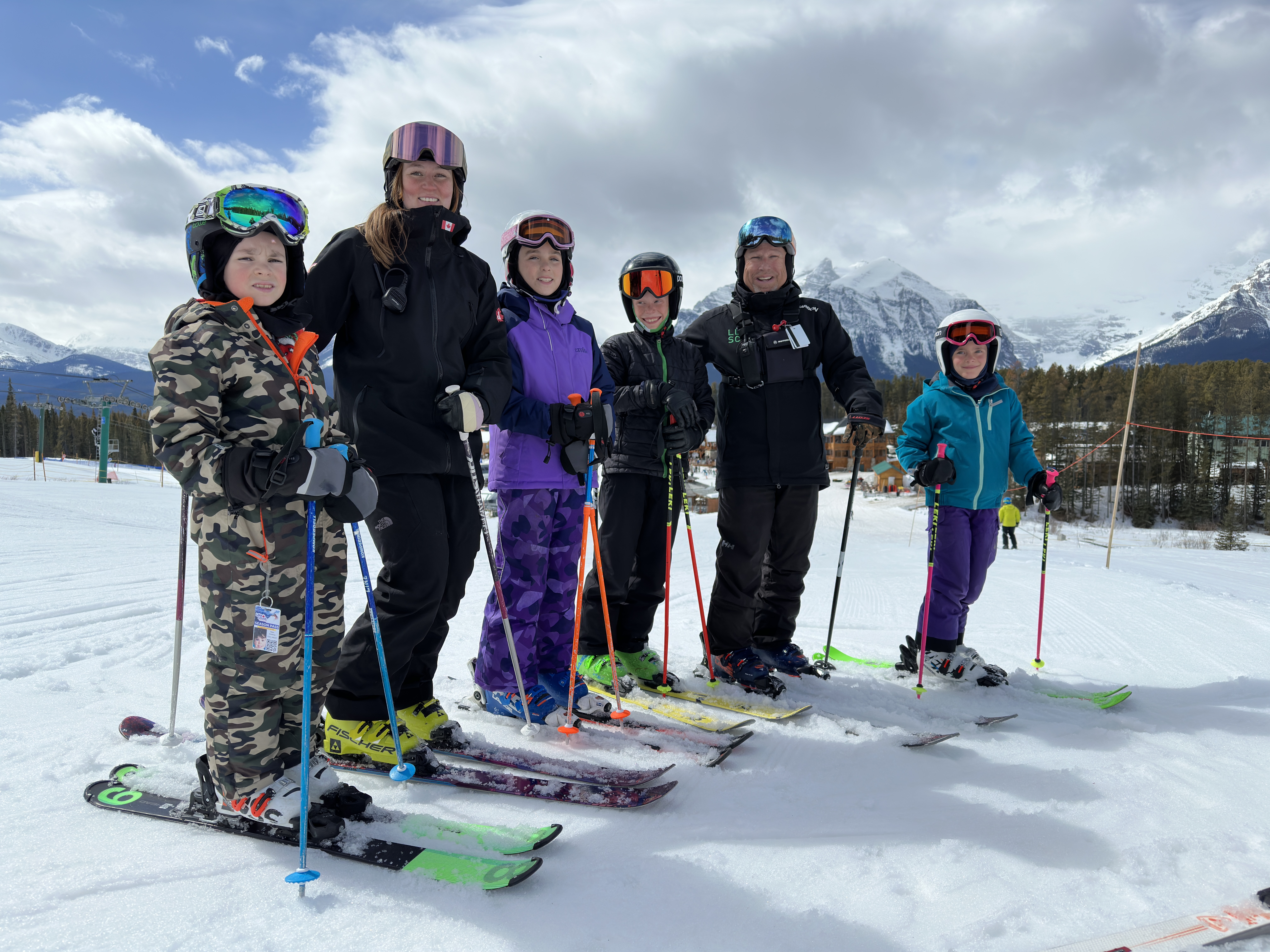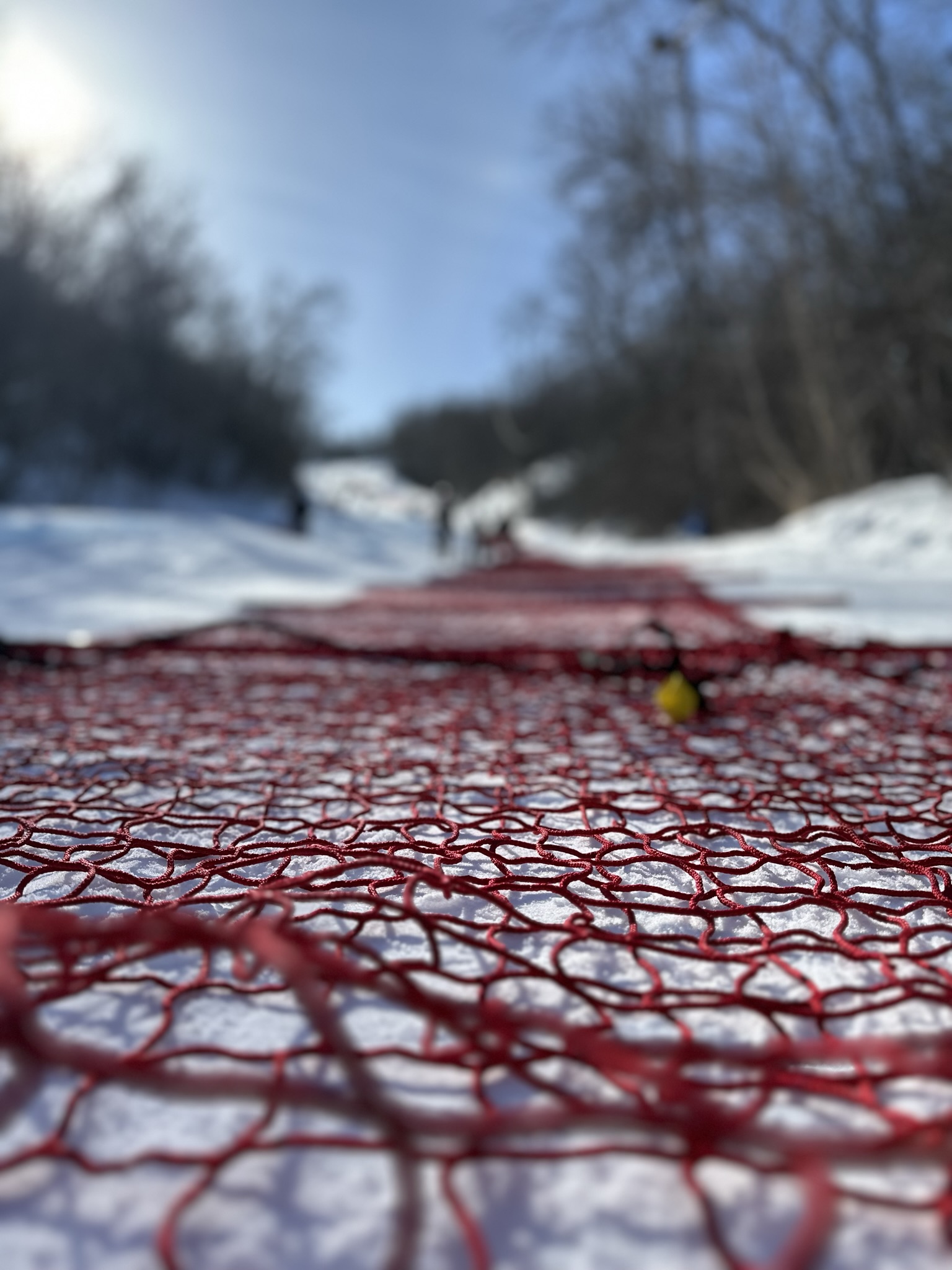Program Levels
Alpine Canada Strive is a eight-step skill framework for the development of CANADA’S future Olympians and for supporting skier participation.
The program provides a holistic approach and added value to Clubs and Ski Schools, offering an evidence-based and practical tool for coaches and instructors, while supporting parents in the education of ACA’s Long-Term Development Model, serving to motivate our youth in reaching their maximum potential.
SKILL LEVEL ATTRIBUTES
- Safety and control
- Experimentation of vertical movement
- Intro to mountain awareness
- Intro to mental skills
- Intro to competitive spirit
CONSIDERATIONS, SKILLS AND KNOWLEDGE ACQUIRED FOR THIS LEVEL
Key Concept: Children should focus on discovering winter sports in a playful environment where they can learn the fundamental movement skills while playing on skis.
Ski Cross: Children should explore and have fun as they discover snow sports, including exploring ski cross terrain elements.
Para-Alpine: The Para-Alpine stage can be entered at any time. Some individuals may have been born with a congenital disability, while others may have acquired their disabilities later in life.
Equipment: The proper equipment set up and fit can help provide the child with a positive sports experience that delivers increased chances of success in developing their fundamental skiing skills.
Health & Wellness: The most important thing to help children develop healthy habits is to lead by example and be a good role model.
Athletic Character: Children should have positive experiences while sliding on the snow. Initially, they create an emotional association with physical activity before developing their passion for their sport. Children at this stage should experience the freedom of play and embrace small successes.
Physical Fitness: Children should focus on learning the fundamental movement skills and linking these fundamental movement skills together to begin participation in structured physical activity at the end of this stage.
Training & Competition: Time on snow is a precious commodity during the winter months. Children should aim to complete more than the minimum number of suggested days on snow because time and mileage on snow in the early years can never be replaced in the later stages of development.
Technical & Tactical Focus: When children begin to ski, the focus should be on maintaining a relaxed stance with flexed ankles keeping equal shin pressure on the front tongue of both ski boots. In the beginning, lateral balance is more neutral than fore-aft.
SKILL LEVEL ATTRIBUTES
- Introduction to turning
- Experimentation of fore-aft movement
- Maintain of vertical movement
- Intro to lower leg joint mobility
- Vertical explosiveness
- Intro to mental skills
- Intro to competitive spirit
CONSIDERATIONS, SKILLS AND KNOWLEDGE ACQUIRED FOR THIS LEVEL
Key Concept: Children should focus on discovering winter sports in a playful environment where they can learn the fundamental movement skills while playing on skis.
Ski Cross: Children are exploring and having fun as they discover snow sport, including exploring ski cross terrain elements.
Para-Alpine: The Para-Alpine stage can be entered at any time. Some individuals may have been born with a congenital disability, while others may have acquired their disabilities later in life.
Equipment: The proper equipment set up and fit can help provide the child with a positive sports experience that delivers increased chances of success in developing their fundamental skiing skills.
Health & Wellness: The most important thing to help children develop healthy habits is to lead by example and be a good role model.
Athletic Character: The goal in this stage is for young children to have positive experiences while sliding on the snow. Initially, children create an emotional association with physical activity before developing their passion for their sport. Children in this stage should experience the freedom of play and embrace small successes.
Physical Fitness: Children should focus on learning the fundamental movement skills and linking these fundamental movement skills together to begin participation in structured physical activity at the end of this stage.
Training & Competition: Time on snow is a precious commodity during the winter months. Children should aim to complete more than the minimum number of suggested days on snow because time and mileage on snow in the early years can never be replaced in the later stages of development.
Technical & Tactical Focus: When children begin to ski, the focus should be on maintaining a relaxed stance with flexed ankles keeping equal shin pressure on the front tongue of both ski boots. In the beginning, lateral balance is more neutral than fore-aft.
SKILL LEVEL ATTRIBUTES
- Introduction to turning and carving skills
- DragMaintaining vertical and fore-aft movement
- Introduction to lower body rotational movement
- Introduction to lateral movement
- Introduction of pole plant
- Intro to mental skills
- Intro to competitive spirit
CONSIDERATIONS, SKILLS AND KNOWLEDGE ACQUIRED FOR THIS LEVEL
Key Concept: Children should continue to develop fundamental movement and skiing skills in fun, structured and unstructured environments.
Ski Cross: Skiers are still in the discovery stage while they continue to develop individual ski cross skills by exploring ski cross terrain elements.
Para-Alpine: Skiers have been introduced to skiing and have started their skiing skill development. They are encouraged to master the fundamental movement skills while developing their skiing skill technical foundation.
Equipment: The proper equipment set up and fit can help provide the child with a positive sports experience that delivers increased chances of success in developing their fundamental skiing skills.
Health & Wellness: The most important thing to help children develop healthy habits is to lead by example and be a good role model.
Athletic Character: Skiers are motivated by the desire to have fun with friends and family while skiing. They are beginning to develop their self-esteem that is nurtured through the reinforcement of their effort, creativity, enjoyment and learning new skills.
Physical Fitness: Young skiers begin to be more independent and physically active. They are more involved with friends and start thinking in more complex ways.
Training & Competition: The primary goal is to develop solid technical skill execution in all situations and environments at varying speeds.
Technical & Tactical Focus: The focus remains on the discovery of skiing and fun while consolidating the fundamental technical skiing skills in fun structured and unstructured environments.
SKILL LEVEL ATTRIBUTES
- Maintaining turning and carving skills
- Developing vertical, lateral, fore-aft and lower body rotational movement
- Developing use of the pole
- Lateral explosiveness
- Linear quickness of feet
- Development of mental skills
- Development of competitive spirit
CONSIDERATIONS, SKILLS AND KNOWLEDGE ACQUIRED FOR THIS LEVEL
Key Concept: Children should continue to develop fundamental movement and skiing skills in fun, structured and unstructured environments.
Ski Cross: Skiers are still in the discovery stage while they continue to develop individual ski cross skills by exploring ski cross terrain elements
Para-Alpine: Skiers have been introduced to skiing and have started their skiing skill development. They are encouraged to master the fundamental movement skills while developing their skiing skill technical foundation.
Equipment: The proper equipment set up and fit can help provide the child with a positive sports experience that delivers increased chances of success in developing their fundamental skiing skills.
Health & Wellness: The most important thing to help children develop healthy habits is to lead by example and be a good role model.
Athletic Character: Skiers are motivated by the desire to have fun with friends and family while skiing. They are beginning to develop their self-esteem that is nurtured through the reinforcement of their effort, creativity, enjoyment and learning new skills.
Physical Fitness: Young skiers begin to be more independent and physically active. They start thinking in more complex ways.
Training & Competition: The primary goal is to develop solid technical skill execution in all situations and environments at varying speeds.
Technical & Tactical Focus: The focus remains on the discovery of skiing and fun while consolidating the fundamental technical skiing skills in fun structured and unstructured environments.
SKILL LEVEL ATTRIBUTES
- Experimentation in all planes
- Timing, coordination, rhythm
- Use of the pole, if needed
- Rotational stability
- Intro to race disciplines
- Development of mental skills
- Development of competitive spirit
CONSIDERATIONS, SKILLS AND KNOWLEDGE ACQUIRED FOR THIS LEVEL
Key Concept: Ski racers are introduced to a variety of critical race elements from start to finish, including movement over terrain and gliding.
Ski Cross: Ski cross courses and terrain features are utilized to develop a ski racer's athleticism and ability to move efficiently over terrain in competitive and non-competitive environments.
Para-Alpine: Skiers are introduced to more formalized ski race training through a learn to race program, including exposure to different snow and terrain conditions. They can load and unload lifts independently.
Equipment: The proper equipment set up and fit can help provide the young skier with a positive sports experience that gives the skier increased chances of having success with developing their fundamental skiing skills.
Health & Wellness: Raising active ski racers in today's busy world can be challenging as ski racers become more involved in ski racing. During this stage, ski racers feel more pressure to perform. Parents should ensure that ski racers get plenty of rest and regeneration time with the increasing demands from sports participation and their social lives.
Athletic Character: Ski racers are encouraged to recognize the importance of developing a positive work ethic and taking responsibility for their performances in both practice and competition. They are beginning to learn how to accept mistakes and setbacks as learning opportunities while celebrating success resulting from their work ethic.
Physical Fitness: Young ski racers enjoy being more independent and physically active. They are more involved with friends and seek to spend more time participating in various activities with their peers.
Training & Competition: The primary goal is to develop solid technical skill execution in all situations and environments at varying speeds. Ski racers begin to understand the use of dynamic, athletic turns in the different training environments,
Technical & Tactical Focus: The ski racer's coordination of movement will become more consistent in a variety of on-snow environments. As ski racers gain strength and confidence in their skiing skills, their technical skiing skill execution will become more consistent and appear to be seamless regardless of the environment.
SKILL LEVEL ATTRIBUTES
- Improvising in all planes
- Experimentation in all environments
- Rhythm and fluidity
- Intro to race disciplines
- Development of mental skills
- Development of competitive spirit
CONSIDERATIONS, SKILLS AND KNOWLEDGE ACQUIRED FOR THIS LEVEL
Key Concept: Ski racers are introduced to a variety of critical race elements from start to finish, including movement over terrain and gliding.
Ski Cross: Ski cross courses and terrain features are utilized to develop a ski racer's athleticism and ability to move efficiently over terrain in competitive and non-competitive environments.
Para-Alpine: Skiers are introduced to more formalized ski race training through a learn to race program, including exposure to different snow and terrain conditions. They can load and unload lifts independently.
Equipment: The proper equipment set up and fit can help provide the young skier with a positive sports experience that gives the skier increased chances of having success with developing their fundamental skiing skills.
Health & Wellness: Raising active ski racers in today's busy world can be challenging as ski racers become more involved in ski racing. During this stage, ski racers feel more pressure to perform. Parents should ensure that ski racers get plenty of rest and regeneration time with the increasing demands from sports participation and their social lives.
Athletic Character: Ski racers are encouraged to recognize the importance of developing a positive work ethic and taking responsibility for their performances in both practice and competition. They are beginning to learn how to accept mistakes and setbacks as learning opportunities while celebrating success resulting from their work ethic.
Physical Fitness: Young ski racers enjoy being more independent and physically active. They are more involved with friends and seek to spend more time participating in various activities with their peers.
Training & Competition: The primary goal is to develop solid technical skill execution in all situations and environments at varying speeds. Ski racers begin to understand the use of dynamic, athletic turns in the different training environments.
Technical & Tactical Focus: The ski racer's coordination of movement will become more consistent in a variety of on-snow environments. As ski racers gain strength and confidence in their skiing skills, their technical skiing skill execution will become more consistent and appear to be seamless regardless of the environment.
SKILL LEVEL ATTRIBUTES
- Awareness of gliding and acceleration in turns
- Improvisation in all environments
- Intro to tactical awareness
- Lower leg joint sensitivity and precision
- Development of mental skills
- Development of competitive spirit
CONSIDERATIONS, SKILLS AND KNOWLEDGE ACQUIRED FOR THIS LEVEL
Key Concept: Ski racers are focused on transferring fundamental technique and basic tactical skills into the competitive environment. They are introduced to a variety of critical race elements from start to finish, including movement over terrain and gliding. Racers begin formalized speed and ski cross training progressions to develop their skill sets in these areas.
Ski Cross: Ski racers continue to consolidate their technical skiing skills, develop their overall athleticism, physical fitness capacity and begin to apply their technical skills in a competitive environment through the introduction of tactical strategy in ski cross beginning with 4-up team event with an individual qualification time trial to 4-up heats with qualification time trial events.
Para-Alpine: Ski racers can take part in local, provincial and international (WPAS) events. They can load and unload lifts independently. They are comfortable skiing on all terrain.
Equipment: The proper equipment set up and fit can help provide ski racers with a positive sports experience that gives them increased chances of having success in training and competition. Ski racers seeking the competitive pathway will have their boots professionally fit and will begin to learn how to tune and maintain their equipment on a daily basis.
Health & Wellness: Raising active ski racers in today's busy world can be challenging as ski racers become more involved in ski racing. During this stage, ski racers feel more pressure to perform. Parents should ensure that ski racers get plenty of rest and regeneration time with the increasing demands from sports participation and their social lives.
Athletic Character: Ski racers are encouraged to develop a positive work ethic and responsibility for their performances in training and competition. They are learning how to accept mistakes and setbacks as learning opportunities while celebrating success resulting from their hard work. Ski racers are developing foundational mental skills that lead to enjoyment and success in ski racing.
Physical Fitness: Physical fitness becomes a priority at this stage. Ski racers begin participating in formalized ski conditioning off-snow training sessions. Both aerobic and strength trainability depend on the maturation level of the skier. They are encouraged to continue to practice the fundamental movement skills through the growth spurt along with maintaining flexibility, speed and strength.
Training & Competition: The primary goal is to continue the refinement of technical skiing skill execution in a variety of training and competition environments at varying speeds to build the ski racer. Ski racers begin to apply tactical strategy through the use of discipline-specific courses that begin to simulate competition environments and utilize drill courses to apply proper ski technique in a variety tactical situations.
Technical & Tactical Focus: The primary goal is to develop solid technical skill execution in all situations and environments at varying speeds. Ski racers begin to understand the use of dynamic, athletic turns in the different training environments to generate and maintain speed in a variety of tactical environments. Performance is starting to become more consistent in various demanding training and competition environments.
SKILL LEVEL ATTRIBUTES
- Generating and maintaining speed
- Rotational quickness
- Development of tactical awareness
- Event specific race skills
- Development of mental skills
- Development of competitive spirit
CONSIDERATIONS, SKILLS AND KNOWLEDGE ACQUIRED FOR THIS LEVEL
Key Concept: Ski racers are focused on transferring fundamental technique and basic tactical skills into the competitive environment. They are introduced to a variety of critical race elements from start to finish, including movement over terrain and gliding. Ski racers begin formalized speed and ski cross training progressions to develop their skill sets in these areas.
Ski Cross: Ski racers continue to consolidate their technical skiing skills, develop their overall athleticism, physical fitness capacity and begin to apply their technical skills in a competitive environment through the introduction of tactical strategy in ski cross beginning with 4-up team event with an individual qualification time trial to 4-up heats with qualification time trial events.
Para-Alpine: Ski racers can take part in local, provincial and international (WPAS) events. They can load and unload lifts independently. They are comfortable skiing on all terrain.
Equipment: The proper equipment set up and fit can help provide ski racers with a positive sports experience that gives them increased chances of having success in training and competition. Ski racers seeking the competitive pathway will have their boots professionally fit and will begin to learn how to tune and maintain their equipment on a daily basis.
Health & Wellness: Raising active ski racers in today's busy world can be challenging as ski racers become more involved in ski racing. During this stage, ski racers feel more pressure to perform. Parents should ensure that ski racers get plenty of rest and regeneration time with the increasing demands from sports participation and their social lives.
Athletic Character: Ski racers are encouraged to develop a positive work ethic and responsibility for their performances in training and competition. They are learning how to accept mistakes and setbacks as learning opportunities while celebrating success resulting from their hard work. Ski racers are developing foundational mental skills that lead to enjoyment and success in ski racing.
Physical Fitness: Physical fitness becomes a priority at this stage. Ski racers begin participating in formalized ski conditioning off-snow training sessions. Both aerobic and strength trainability depend on the maturation level of the skier. They are encouraged to continue to practice the fundamental movement skills through the growth spurt along with maintaining flexibility, speed and strength.
Training & Competition: The primary goal is to continue the refinement of technical skiing skill execution in a variety of training and competition environments at varying speeds to build the ski racer. Ski racers begin to apply tactical strategy through the use of discipline-specific courses that begin to simulate competition environments and utilize drill courses to apply proper ski technique in a variety tactical situations.
Technical & Tactical Focus: The primary goal is to develop solid technical skill execution in all situations and environments at varying speeds. Ski racers begin to understand the use of dynamic, athletic turns in the different training environments to generate and maintain speed in a variety of tactical environments. Performance is starting to become more consistent in various demanding training and competition environments.
GET STARTED NOW!
The Alpine Canada STRIVE app is FREE to download and use. Parents, skiers and coaches can download the app now and will be guided through the process of creating their accounts and connecting with each other.


.jpg)


